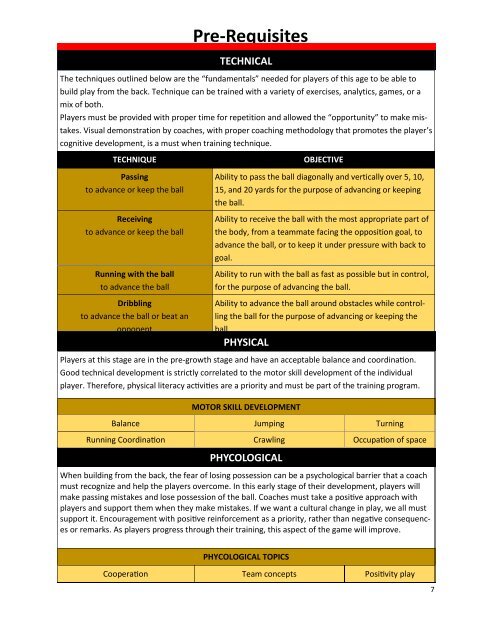Teach Youth Players How to build play from the back
This is the first of The Youth Coaching Series E-Books designed for coaches operating at the youth level. This e-book provides coaches of U11and U12 a comprehensive plan in how progressively teach youth players how to build play from the back in the 9v9 game format.
This is the first of The Youth Coaching Series E-Books designed for coaches operating at the youth level. This e-book provides coaches of U11and U12 a comprehensive plan in how progressively teach youth players how to build play from the back in the 9v9 game format.
You also want an ePaper? Increase the reach of your titles
YUMPU automatically turns print PDFs into web optimized ePapers that Google loves.
Pre-Requisites<br />
TECHNICAL<br />
The techniques outlined below are <strong>the</strong> “fundamentals” needed for <strong>play</strong>ers of this age <strong>to</strong> be able <strong>to</strong><br />
<strong>build</strong> <strong>play</strong> <strong>from</strong> <strong>the</strong> <strong>back</strong>. Technique can be trained with a variety of exercises, analytics, games, or a<br />
mix of both.<br />
<strong>Players</strong> must be provided with proper time for repetition and allowed <strong>the</strong> “opportunity” <strong>to</strong> make mistakes.<br />
Visual demonstration by coaches, with proper coaching methodology that promotes <strong>the</strong> <strong>play</strong>er’s<br />
cognitive development, is a must when training technique.<br />
TECHNIQUE<br />
Passing<br />
<strong>to</strong> advance or keep <strong>the</strong> ball<br />
Receiving<br />
<strong>to</strong> advance or keep <strong>the</strong> ball<br />
Running with <strong>the</strong> ball<br />
<strong>to</strong> advance <strong>the</strong> ball<br />
Dribbling<br />
<strong>to</strong> advance <strong>the</strong> ball or beat an<br />
opponent<br />
OBJECTIVE<br />
Ability <strong>to</strong> pass <strong>the</strong> ball diagonally and vertically over 5, 10,<br />
15, and 20 yards for <strong>the</strong> purpose of advancing or keeping<br />
<strong>the</strong> ball.<br />
Ability <strong>to</strong> receive <strong>the</strong> ball with <strong>the</strong> most appropriate part of<br />
<strong>the</strong> body, <strong>from</strong> a teammate facing <strong>the</strong> opposition goal, <strong>to</strong><br />
advance <strong>the</strong> ball, or <strong>to</strong> keep it under pressure with <strong>back</strong> <strong>to</strong><br />
goal.<br />
Ability <strong>to</strong> run with <strong>the</strong> ball as fast as possible but in control,<br />
for <strong>the</strong> purpose of advancing <strong>the</strong> ball.<br />
Ability <strong>to</strong> advance <strong>the</strong> ball around obstacles while controlling<br />
<strong>the</strong> ball for <strong>the</strong> purpose of advancing or keeping <strong>the</strong><br />
ball<br />
PHYSICAL<br />
<strong>Players</strong> at this stage are in <strong>the</strong> pre-growth stage and have an acceptable balance and coordination.<br />
Good technical development is strictly correlated <strong>to</strong> <strong>the</strong> mo<strong>to</strong>r skill development of <strong>the</strong> individual<br />
<strong>play</strong>er. Therefore, physical literacy activities are a priority and must be part of <strong>the</strong> training program.<br />
MOTOR SKILL DEVELOPMENT<br />
Balance Jumping Turning<br />
Running Coordination Crawling Occupation of space<br />
PHYCOLOGICAL<br />
When <strong>build</strong>ing <strong>from</strong> <strong>the</strong> <strong>back</strong>, <strong>the</strong> fear of losing possession can be a psychological barrier that a coach<br />
must recognize and help <strong>the</strong> <strong>play</strong>ers overcome. In this early stage of <strong>the</strong>ir development, <strong>play</strong>ers will<br />
make passing mistakes and lose possession of <strong>the</strong> ball. Coaches must take a positive approach with<br />
<strong>play</strong>ers and support <strong>the</strong>m when <strong>the</strong>y make mistakes. If we want a cultural change in <strong>play</strong>, we all must<br />
support it. Encouragement with positive reinforcement as a priority, ra<strong>the</strong>r than negative consequences<br />
or remarks. As <strong>play</strong>ers progress through <strong>the</strong>ir training, this aspect of <strong>the</strong> game will improve.<br />
PHYCOLOGICAL TOPICS<br />
Cooperation Team concepts Positivity <strong>play</strong><br />
7



